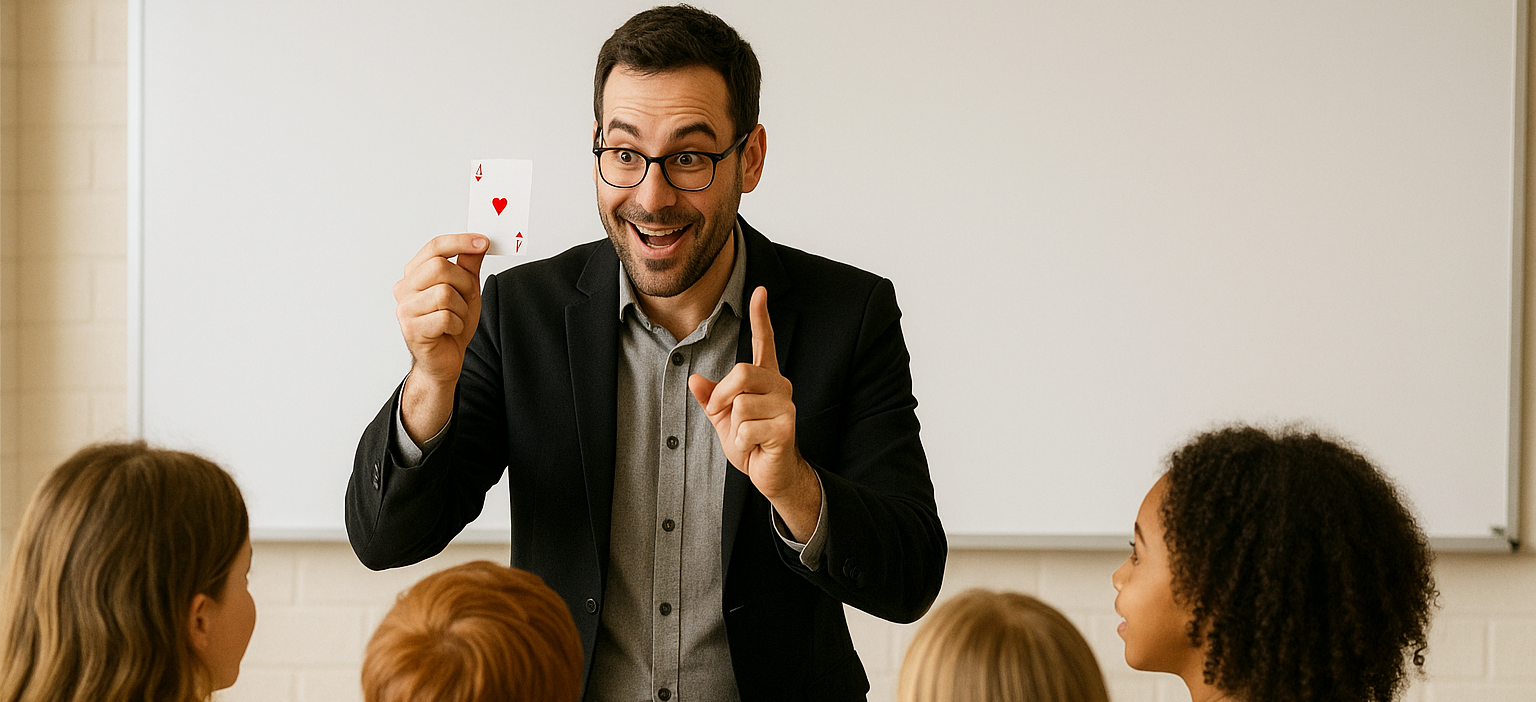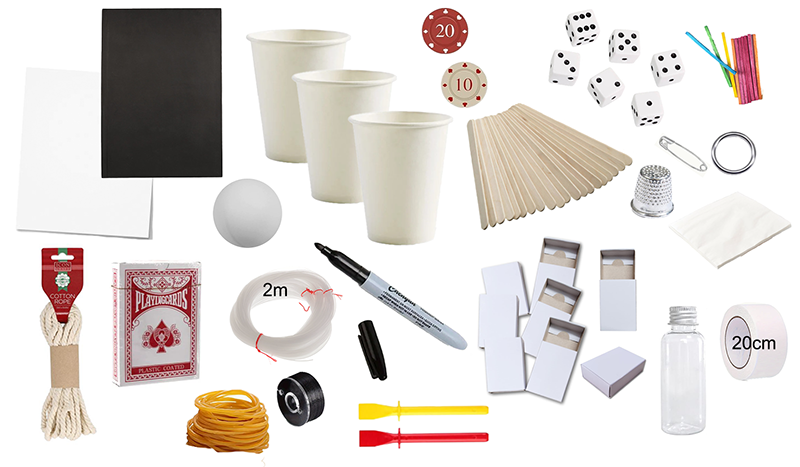
MT - Magic For Teachers
Bring the wonder of magic to your classroom.
There has never been a summer course like this one!
Are you ready to ‘wow’ your students, capture their imagination, and make learning truly magical?
Have you always wanted to be somewhat of a magician?
Well, now you can! We will turn you into an entertainment machine, the teacher with all the tricks!
Whether you're looking to boost engagement, add a little sparkle to your classroom storytelling, or just impress your class during transitions with a little magic, this course is for you!
Joel, our professional magician, will perform and teach you dozens of great magic tricks, including:
- Vanish any small object
- The magic paperclip chain
- The living matchbox
- The mind reading list
- The vanishing pen
- Just think
- The teleporting playing card
- The dancing bottle cap
- The jumping rubber band
- The cut and restored rope
- The floating ring
- Classic cups and balls
- Professor’s nightmare
- Vanish any small object
- The book test
- Teleporting an object
- Broken and restored band
The teaching of the tricks follows the following format:
- Firstly - Joel will perform the trick...to both entertain and ‘WOW’ you with his brilliance!
- Then he’ll take you behind the scenes and show you the ‘trickery’ or ‘deception’ behind the trick and how it works
- Next, he’ll teach you how to smoothly perform the trick so that you, too, can ‘WOW’ your students when back in school
- Finally, you will learn, rehearse and perform the trick yourself
Is it just tricks, or is there a bigger picture?
YES, of course, there is a bigger picture! Besides entertaining you and turning you into a magician, here’s the more significant point:
As we work through the fun magic tricks together, Joel challenges the teacher to reflect on the similarities between the work of a magician (professional entertainer) and the work of a teacher (professional educator) and to extrapolate pointers to work on towards improving own practice. There are 30 reflections across key areas such as the following 7/30 examples -
- Reflection on fostering engagement
- Reflection on how good preparation and repeated practice is key for learning
- Reflection on creating a sense of wonder for students
- Reflection on how to get and keep attention
- Reflection on fostering ‘growth mindsets’
- Reflection on the pointers to effective inclusion
- Reflection on the need for pedagogical knowledge, for both magician and teacher
Along the way, we will also include tricks that support the teaching of mathematics, languages and science, make great use of technology and support the better wellbeing of all. For example -
- Oral Language: students are tasked to choose, practice and perform a trick whilst holding the attention of their audience with a clear and engaging presentation.
- Reading & Writing: students research, read about and write up fact files and biographies on the world’s greatest magicians.
- Technology: students research and choose a trick, script it, rehearse it, perform it and have a fellow student video record it, then review and enjoy their own performance!
- Mathematics: We uncover some of the magic of numbers in mathematics e.g. Magic Squares. We know that card tricks rely on combinations and modular arithmetic. Number guessing tricks use binary numbers, algebra, or patterns, while "Mind Reading" puzzles depend on logic and sequences. Maths is the great friend of the magician!
- Science Magic: float an iron paper clip on water (surface tension), bend water with a comb (static electricity) etc.
- School Showcase: Once a year, host a school-wide ‘Magicians & Magic Day’ and we provide lots of ideas to electrify such an event! This is one that the whole school looks forward to and remembers for ever!
Teachers, if you want to bring even greater joy, wonder, and curiosity into your teaching toolkit, then this course in magic is just for you.
FREE MAGIC PACK (Worth €25) SENT BY POST TO ALL PARTICIPANTS.

Enrol today...and not only will you be a more entertaining teacher, you will also be a fully-fledged magician!
NOTE:
The online format of this course enables you to study at a time and place that best suits your own needs.
You can access your course anytime until March 31st 2026.
Within this highly interactive web-based course, a dynamic learning experience awaits, where you can interact with your fellow course participants through the in-course chat forums and communication tools provided by the CPD College learning system.
Our friendly and knowledgeable tutors actively support each course, providing expert interaction, guidance and feedback for all participants on chat questions and assignments which call for critical reflection, self-analysis and a reasoned response.
On successful completion of your course, you can download and print off your CPD record and certificate of completion.
We look forward to welcoming you to your course.
- In this course, we aim to:
- Immerse teachers in the performance of magic tricks, which in turn springboard them to purposefully and deeply reflect across many of the key themes, principles and practices that support effective and meaningful inclusion
- Consider and reflect on the key indicators of effective practice in relation to the principles underpinning SEN, inclusion and the inclusive classroom
- Set out, explore and summarise the individualised education planning, which should help meet the individual needs of all and may involve differentiation, a range of teaching methods, resources and creatively deployed supports as appropriate
- Itemise, review and reflect on the variety of teaching and learning strategies to support how students prefer to learn and meet their differing needs
- Detail and reflect on the suite of great classroom management practices, protocols and rules that serve to make a classroom more socially, sensorially and learning inclusive
- Highlight inclusive assessment approaches that provide meaningful experiences for all and feedback to pupils and parents/guardians that is age and curriculum appropriate and meaningful
- Innovate and create inclusive maths (PMC) and language (PLC) learning experiences centred on ‘magic themes’ that support pupils to collaborate in a very purposeful, creative and productive manner
- Support students to use digital technologies in creative and highly effective ways to develop knowledge, skills and understanding, whilst working in inclusive groups on ‘magical themes’
- Support pupils to grow as learners in inclusive groups through respectful interactions whilst working on ‘magic-themed’ STEM/science experiences that are challenging and supportive
- Conceive and implement high-level and inclusive ‘magic-themed’ wellbeing actions such as to promote, enhance and nurture school wellbeing for all
| 01 - Through the lens of a series of magic tricks, Joel Richardson, a renowned magician, prompts teachers to make individual reflections on inclusion. He challenges teachers to reflect on and consider key inclusion themes that connect what a magician does with the work of a teacher/school team, seeking to create a more inclusive school/classroom.
He entertains, engages and challenges. The format for each of the four trick presentations arc across five steps in each module:
Exemplar - Magic Trick
We provide great guidance synthesised from the latest research and key Department of Education publications to support teacher reflections on key themes. We present learner experiences, connecting magic and mathematics in the classroom to engage all students in inclusive groups, e.g. Number Tricks (Arithmetic), Card Tricks (Probability), Magic Squares (Patterns), Mind Reading Tricks (Logic), Rope & Knot Tricks (Geometry), etc. |
| 02 - A child-centered and needs-based approach to inclusion. Joel presents another four tricks and follows the same arcs across the five presentation steps as outlined previously.
Exemplar Magic Trick
We explore a suite of key themes, e.g. effective teacher preparation, curriculum planning for inclusion, a ‘child-centred / needs-based’ approach, learner outcomes focused, etc. and provide great guidance synthesised from the latest research and Department publications. We present exciting ‘magic-themed’ oral, reading, writing language experiences for inclusive groups to work on together, focusing on strands and elements of PLC, e.g. select, rehearse and present magic tricks, explain how a trick works, write instructions for performing a trick, write magic spells, recite spells, etc. |
| 03 - Instructional strategies, accommodations & modifications Joel presents another four tricks and follows the same arcs across the five presentation steps as outlined previously.
Exemplar Magic Trick: The Jumping Rubber Band Trick.
We detail effective teaching strategies that involve the use of suitable teaching and learning methodologies, materials and arrangements to include co-operative teaching, differentiation and the promotion of positive classroom relationships, supporting all pupils who learn differently and who have individual needs. We provide good guidance on the teaching and learning experiences that particularly support pupils who learn differently and who have individual needs. We explore and instance how digital technologies can play a huge role in supporting inclusion in the primary classroom. Our pointers to effective practice and reflection guidance on module themes are synthesised from recent DE publications. We outline a series of ‘magic-themed’ digital projects that teachers can engage with their students in inclusive groups: Digital Spellbooks (Google Slides, Book Creator), Green Screen Wizardry, Coding a Magical World (Scratch), AI Spell Generator, Escape Room with QR Codes, Magical Stop-Motion Animation etc. |
|
04 - Classroom management strategies to support inclusion. Joel presents four more tricks and follows the same arcs across the five presentation steps as outlined previously. Exemplar Trick
We explore the classroom management & organisation practices in terms of layout, access to materials, visual structure, schedules, predictability, etc., which all coalesce to contribute to a positive classroom experience for pupils, not just with SEN but all pupils. We contend that the best spaces to be in are actively managed by teachers, ensuring that classroom protocols and rules promote learning & address challenging behaviour. Our guidance is synthesised from recent DE documents. We conclude with engaging, fun science (STEM) activities around the theme of magic e.g. magical potions (chemical reaction), Invisible Ink (Acids & Bases), Floating Objects (Density & Buoyancy), Static Electricity Wands (Electricity & Forces), Colour-Changing Potions (pH Indicators), Optical Illusions (Light & Perception), Walking Water (Capillary Action) |
|
05 - Inclusive assessment practices and the good wellbeing of all. Joel presents four more tricks that dovetail into assessment & wellbeing reflections and follows the same arcs across the five presentation steps as outlined previously. Exemplar Trick
We ask teachers to reflect on their own preparation & inclusive assessment practices, which should provide meaningful experiences & feedback to pupils and parents/guardians and which should be age, stage, curriculum & needs appropriate. Inclusive assessment includes both formal and informal methods. We spotlight & explore indicators of effective practice in promoting pupils’ well-being and their emotional and physical safety as an over-arching and fundamental feature of school life. Our effective practice pointers on themes is synthesised from recent DE publications. In addition to suggesting reams of activities and magical ideas for the implementation of a “One Day for Magic” schoolwide once a year, we set out and develop ‘magic’ wellbeing promoting activities and ideas such as: Magical Mindfulness, Acts of Kindness Spells, Enchanted Affirmations, Mystical Mood Tracking, Magical Mistakes Spell, Magical Safe Spaces, Magical Storytelling etc. |
